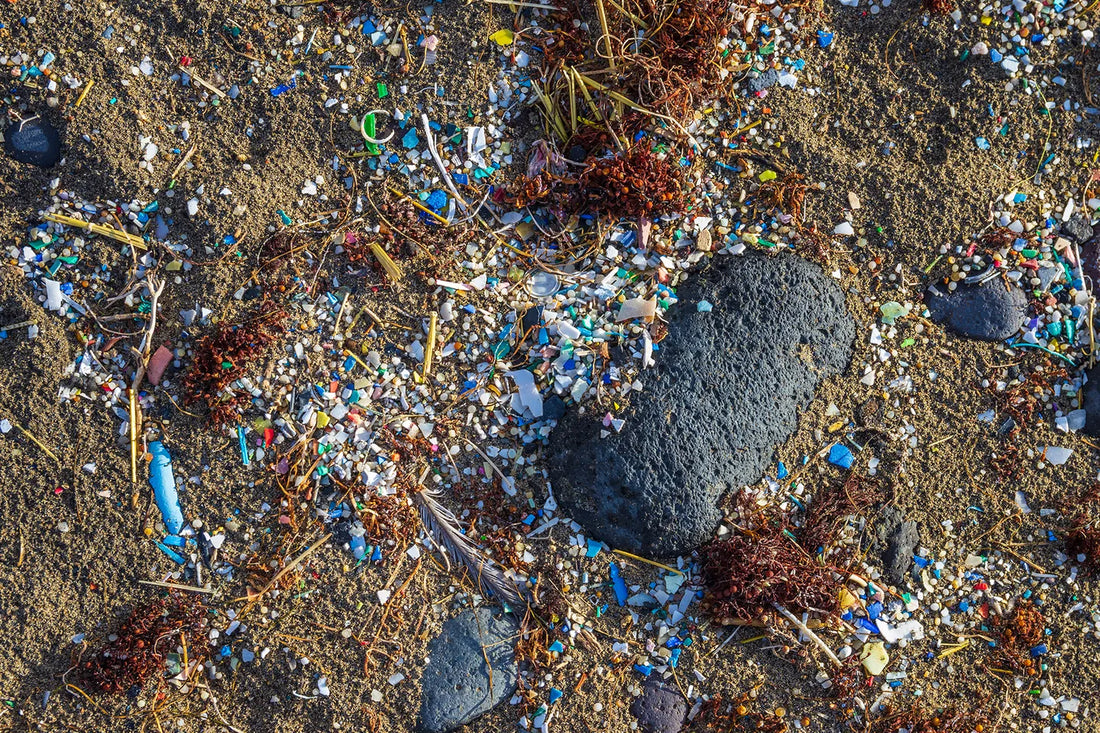
5 min read
Understanding Microplastics: What They Are and What You Can Do About Them
We delve into how microplastics infiltrate our ecosystems and the small changes that can help to mitigate their impact in our homes.
WORDS Elissa Rose
Microplastics have become a pervasive environmental and health concern, capturing global attention due to their prevalence and potential dangers. These tiny plastic particles, measuring less than five millimeters in diameter, are found in oceans, soil, air and even our food. Understanding what microplastics are and why they pose significant risks is crucial for tackling this widespread issue.
Microplastics can be found in various household items and spaces. Synthetic fabrics like polyester and nylon shed microfibers, a subcategory of microplastics, during washing, which a study by the American Chemical Society found entering waterways through laundry wastewater. A single wash load can release several million microfibers. Plastic containers and packaging can release microplastics into food and beverages, especially when exposed to heat. Additionally, household dust often contains microplastic particles from furniture, carpets and electronic devices, making it a common source of indoor exposure.
What Are Microplastics?
Microplastics are fragmented pieces of plastic that originate from larger plastic debris or are manufactured as microscopic particles. Microplastics are found everywhere, from the depths of the oceans to the peaks of remote mountains. Studies have even detected them in rainwater and Antarctic ice, highlighting their ability to travel long distances through air and water. They are broadly categorized into two types:
Primary Microplastics: These are intentionally created for use in products such as cosmetics, toothpaste and industrial applications. Microbeads, commonly found in exfoliants and cleansers, are a notable example.
Secondary Microplastics: These result from the breakdown of larger plastic items like bottles, bags and fishing nets due to environmental factors such as sunlight, heat and wave action. This fragmentation process creates countless tiny particles that are nearly impossible to recover.
"A single wash load can release several million microfibers."
Why Are Microplastics Dangerous?
Environmental Impact:
Microplastics pose a grave threat to ecosystems. In aquatic environments, they are ingested by marine organisms, often mistaken for food. This ingestion can lead to malnutrition, poisoning and death for species ranging from plankton to whales. Furthermore, microplastics act as vectors for harmful pollutants, such as pesticides and heavy metals, which attach to their surfaces. When these contaminated particles are consumed by marine life, they move up the food chain, potentially affecting predators, including humans.
Terrestrial ecosystems are not immune. Microplastics in soil disrupt microbial communities vital for nutrient cycling and plant growth. Agricultural practices that involve the use of plastic mulch or sewage sludge inadvertently introduce microplastics into the soil, threatening long-term soil health and productivity.
Human Health Risks:
The presence of microplastics in the human body raises alarms about potential health impacts. Studies have detected microplastics in drinking water and even the air we breathe. One study estimates that the average adult consumes approximately 2,000 microplastics per year through salt alone. A person consuming seafood may unknowingly ingest microplastics accumulated in the tissues of fish and shellfish.
Microplastics may cause harm through several mechanisms, including irritating tissues and organs when ingested or inhaled. Emerging research suggests that microplastics can trigger inflammatory responses in the body, potentially contributing to conditions like autoimmune diseases and carcinogenesis. They also often contain additives like flame retardants and phthalates, which are linked to endocrine disruption, reproductive issues and certain cancers. Additionally, microplastics can absorb environmental toxins, amplifying their potential harm.
What Can Be Done?
- Consider food preparation and cooking methods: Replace plastic cooking utensils and chopping boards for those made from wood or titanium. Use stainless steel and cast iron cookware in place of pans with non-stick coatings which can release Per- and Polyfluoroalkyl Substances (PFAS).
- Use reusable items: Opt for reusable cloth bags and glass bottles and containers instead of single-use plastics.
- Choose natural fabrics: Select clothing made from cotton, wool or other biodegradable materials over synthetic fabrics like polyester and nylon.
- Use a microfiber-catching laundry bag: Wash synthetic clothes in bags designed to capture microfibers to prevent them from entering wastewater systems.
- Properly dispose of plastic waste: Ensure plastics are recycled correctly to avoid fragmentation into microplastics.
- Avoid products with microbeads: Check labels and avoid personal care products that contain microbeads.
- Support sustainable brands: Purchase items from companies that prioritize biodegradable packaging and environmentally friendly practices.
- Vacuum and dust regularly: Reduce indoor exposure by cleaning to remove microplastic particles from household dust.
- Avoid heating plastics: Do not microwave food in plastic containers or expose them to high heat to prevent microplastic release.
- Support clean water initiatives: Use water filters capable of trapping microplastics if your local water supply is contaminated. Reverse osmosis filters have been shown to be the most effective.
- Use an external filter for your washing machine: Invest in filter systems, such as those developed by PlanetCare, that will take out up to 98 percent of microfibers from your laundry.
- Use cold water for laundry where possible: This practice releases fewer microfibers than hot water.
- Dry laundry on a clothesline: The use of dryers releases additional microfibers into the air from the dryer vent.
Microplastics are a silent yet omnipresent threat, infiltrating every corner of our planet and impacting ecosystems and human health alike. Addressing this issue requires collective effort and innovative solutions. By taking steps to reduce plastic consumption and support sustainable practices, we can mitigate the dangers of microplastics and move towards a healthier, more sustainable future.
Feature Image: GaiBru Photo/Adobe


